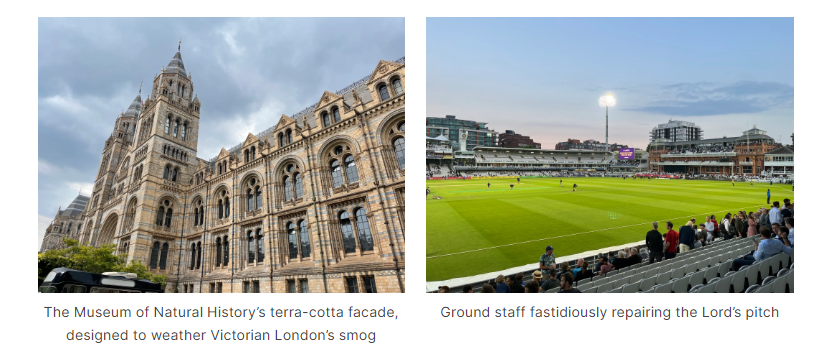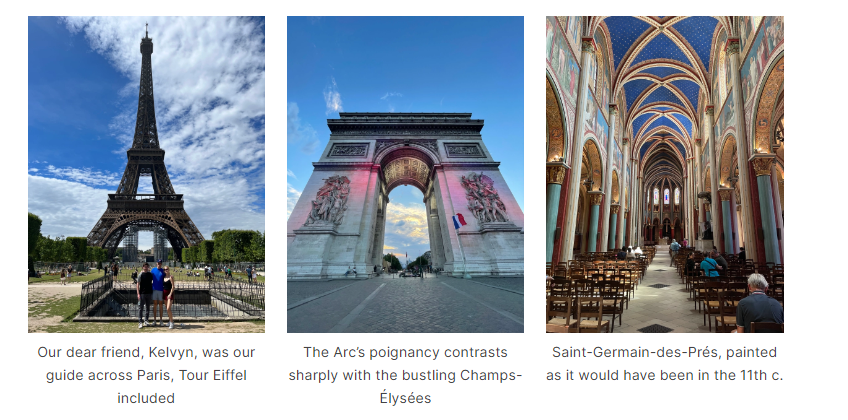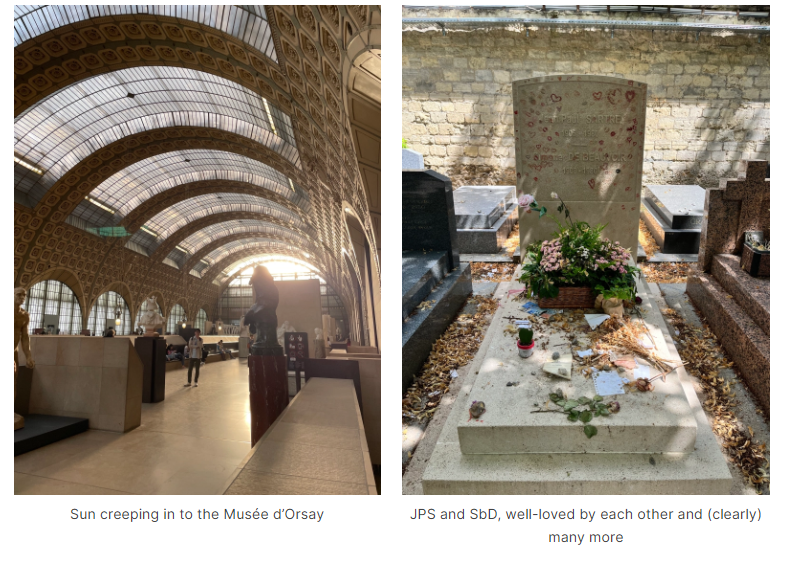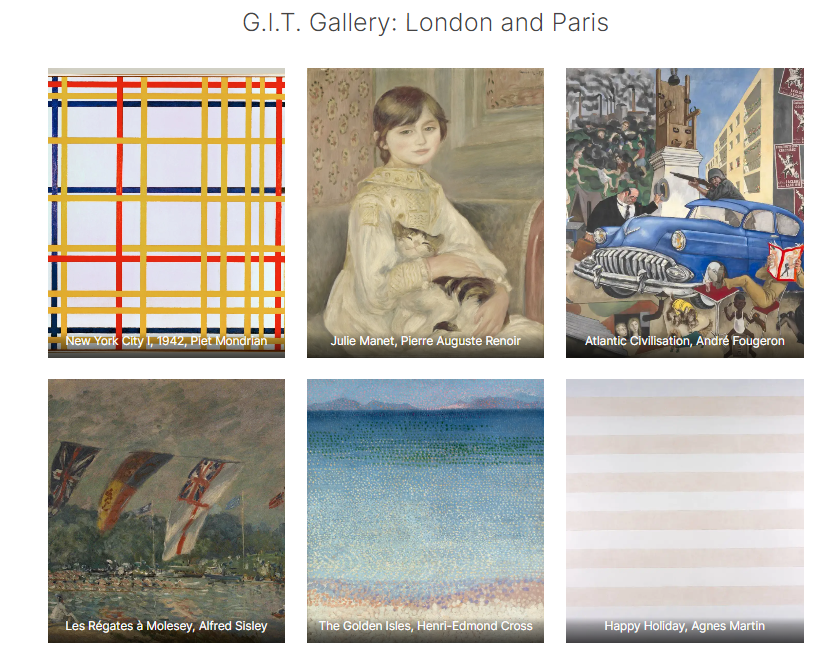Cosmopolitanism and (De-)construction
For the Original Post please go to: https://greatideastour.wordpress.com/london-and-paris/
With friends arriving from ‘divers and sundry’ places, meals with origins across the globe, and an artistic and cultural scene almost as far-reaching, London presented myriad opportunities for yr. correspondent and his associate to realize the ideal of cosmopolitanism (at least in the looser, more popular sense). Here, before I move to the philosophical meat and potatoes, I’ll outline our time in the city; I encourage the reader to assess our efforts as cosmopolites—and to offer marks over text, email, &c.
Day (1): Industrial action shut down the Underground, which afforded Bree and I more time to explore the Kensington Gardens. Foreshadowing our eventual Parisian stay, we broke fast at the terrific Cafe Montparnasse, gorging ourselves on fine pastries, sandwiches, and salads. Later, perched adjacent to the garden’s Italian fountains, I reunited with a friend from high school, who was completing a European tour of his own; I felt fortunate to hear about the context he gathered whilst abroad, how he intends to apply it to his new job in NYC, and where, despite our divergent paths, we might next reconnect. In the sun-speckled early evening, yr. correspondent bought and kicked around a football, then ate some delicious aglio e olio.

Day (2): Our first priority was a visit to the Tate Modern, with a contemporary art collection second to few. Located therein, surprisingly enough, is a room devoted to my favorite American painter, Agnes Martin; to me, her work, in its tight geometry, mixture of simplicity and complication, and purity, is innocence. For dinner, Bree and I divided and conquered, meeting two Londoners (of sorts): she, her roommate on a month-long study abroad; myself, another old friend, a UA and Cambridge graduate who has spent the last year settled near St Paul’s.

Day (3): We started at the Museum of Natural History; Bree, a geologist at heart, esp. enjoyed interactive exhibits on planetary features and rock formations—the kid in me, however, was partial to dinosaur displays. Minds enriched and bellies empty, we turned to a Greek restaurant, and souvlaki rained down like manna from heaven. At night, yr. correspondent made a pilgrimage to Lord’s, the home of cricket, where Essex triumphed over Middlesex via tight bowling and three particularly sharp catches.

The variety of cuisines, experiences, and people detailed above is characteristic of London—or, better, it is historically-embedded. Indeed, upon the 11 c. arrival and conquest of the Normans, the city expanded from the largest Anglo-Saxon port to England’s administrative and cultural capital, positioning it as a gate to the world. Thus, Londoners today are (self-)labeled as such—instead of ‘English’ or ‘British’—both within and outside of the U.K., a veritable verbal relic of its cosmopolitan status.
And to this end, as we approached our subsequent destination, a question lingered in my mind: if Londoners aren’t ‘English,’ are Parisians not French?
Au contraire, they most certainly are!—acc. to the natives with which we shared our final meal, a(nother) Korean BBQ feast. Well, why might such a discrepancy exist?
One could attribute the phenomenon to the ‘traditionally French’ architectural, social, and artistic features maintained in the city: its medieval churches, like Saint-Severin and -Germain-des-Prés, and, later, the Arc de Triomphe, Tour Eiffel, &c. These former, ecclesiastical structures, which (yr. correspondent learned in the Musée de Cluny) situated Paris as Europe’s cultural and intellectual cradle in the Middle Ages; in London, by contrast, they were lost in successive, devastating fires.

Moreover, such churches, and the complex religio-political matrix they represented, proved foil to the Enlightenment, (perhaps) Paris’ initial experiment with deconstruction. (N.B. I mean deconstruction in its less technical, more vernacular sense: i.e., the critical interrogation of the concepts and values that govern discourse and life—re: Enlightenment, the supremacy of the monarch, the consequent indivisibility of church and state, personhood through a parochial religion.)
Even so, these new modes of thought became as ensconced as the conservative attitudes they overcame; and, in the midst (and wake) of France’s more global posture, achieved via a pernicious empire and otherwise, they too were examined. E.g., the impressionism of Renoir and Monet, which I witnessed with awe at the Musée d’Orsay, and which was, in the latter case, influenced heavily by Japanese gardens and prints, outpaced the romantic Delacroix and calculating Ingres. Similarly, Jean-Paul Sartre and Simone de Beauvoir, champions of existentialism buried at the Montparnasse Cemetery, built upon eastern thought; so too did Derrida, father of deconstructionism proper.

I hear you saying, “Jackson, you’ve only just described Hegel—thesis, antithesis, and synthesis across historical time.” To this, I would contend that, after a material and/or social change shapes Paris, its range of future possibilities fundamentally shift (thereby differing it from its preceding character). It’s a place that’s always being (de-)constructed; there’s a two-story McDonald’s on the Champs-Élysées.

And—if you’ll bear with me, returning to my original query—it now feels rather silly to ask whether Parisians are French; for, what might such terms even signify? How can we justifiably articulate that someone ‘belongs’ to a place? Because they are born of its unique socioeconomic inputs? These, past and present, have existed in complex, interlocking webs that allay near description.
Deconstruction, then, insists that we, through repeat valuation and inquiry, resist the affiliations that challenge the type of (nationless) multiculturalism London embraces—and understand and appreciate the evolving ideas and practices that make Paris a welcome tesserae in our planetary mosaic. This is cosmopolitanism in its truest form.
G.I.T. Gallery: London and Paris

Bree’s ‘Fun Corner’:
London: Seems almost English, but not really. Incredibly metropolitan, bustling, and a melting pot of more countries and regions than you can name. Combines to make a beautiful mixture of stories every place you go. Dog viewing: 10/10, especially in Kensington Gardens. (Best spots: OPA Souvlaki, Tate Modern, Cafe Montparnasse, Kensington Gardens)
Paris: Very nerve wracking to step into after nearly a month on the Isles, but when accompanied by friends it is much more palatable. Most Parisians, contrasting their reputation, are incredibly nice and welcoming — especially the one who gave us a free croissant, but not so much the couple that jump-scared me. Overall a lovely city that would be worthwhile to visit again to see everything we missed. Dog viewing: 6/10, not very many, but the one I saw chewing a little bone on the metro made up for it. (Best spots: La Parisienne Odessa, Centre Pompidou, Musée d’Orsay, Pho Odessa, walking anywhere always provides entertainment!)